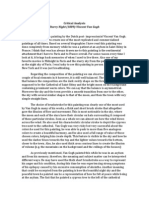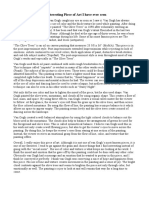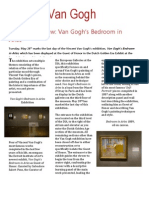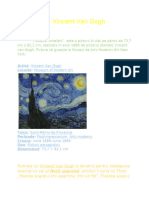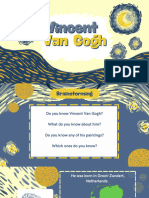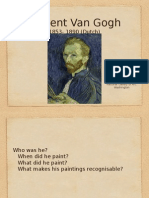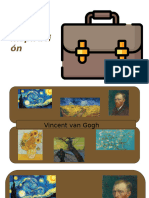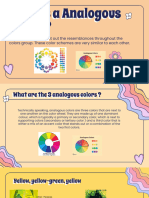0 ratings0% found this document useful (0 votes)
169 viewsVan Gogh - The Sunflowers
Van Gogh - The Sunflowers
Uploaded by
Rennik-Jan Neggersa short analysis of the painting 'the sunflowers' by Van Gogh. It talks about the symbolism, the painting techniques, and the background story of his personal life.
Copyright:
© All Rights Reserved
Available Formats
Download as DOCX, PDF, TXT or read online from Scribd
Van Gogh - The Sunflowers
Van Gogh - The Sunflowers
Uploaded by
Rennik-Jan Neggers0 ratings0% found this document useful (0 votes)
169 views1 pagea short analysis of the painting 'the sunflowers' by Van Gogh. It talks about the symbolism, the painting techniques, and the background story of his personal life.
Copyright
© © All Rights Reserved
Available Formats
DOCX, PDF, TXT or read online from Scribd
Share this document
Did you find this document useful?
Is this content inappropriate?
a short analysis of the painting 'the sunflowers' by Van Gogh. It talks about the symbolism, the painting techniques, and the background story of his personal life.
Copyright:
© All Rights Reserved
Available Formats
Download as DOCX, PDF, TXT or read online from Scribd
Download as docx, pdf, or txt
0 ratings0% found this document useful (0 votes)
169 views1 pageVan Gogh - The Sunflowers
Van Gogh - The Sunflowers
Uploaded by
Rennik-Jan Neggersa short analysis of the painting 'the sunflowers' by Van Gogh. It talks about the symbolism, the painting techniques, and the background story of his personal life.
Copyright:
© All Rights Reserved
Available Formats
Download as DOCX, PDF, TXT or read online from Scribd
Download as docx, pdf, or txt
You are on page 1of 1
This painting is painted by Vincent van Gogh.
Vincent van Gogh was a Dutch painter that was born in
1853, but who spent much of his life in France. Van Gogh is considered to be one of the leading
painters of post-impressionism. Post-impressionism was an art movement that flowed from
impressionism around the 1880s. Contrary to impressionism which tries to capture spontaneity and
natural light and colour in its paintings, post-impressionism rather used their paintings to express
emotions through symbolism and colours, regardless of the form or composition of the content. This
may sound too abstract, but as soon as we go into the painting itself it becomes more clear.
Van Gogh painted a series of paintings featuring sunflowers, and this particular painting shows a vase
with 14 sunflowers, and was painted in 1888. This painting by Van Gogh is a good example of a post-
impressionist painting in which emotions are expressed through symbolism and colour. Let me
demonstrate this by asking a question. If you would just look at this painting, would your impressions
then say that van Gogh painted this in; (a) a period of depression; (b) a period of normality; or (c) a
period of intense happiness? Hopefully you were thinking of the third option a period of happiness.
If you look at the painting, the first and inevitable thing you notice are the many bright yellows that
Van Gogh used. By using the bright colour yellow, and by experimenting with yellow on yellow on
yellow on yellow, the abundance of this colour immediately gives a feeling of lightness and
cheerfulness.
If you would next think about the contents of the painting, it also appeals to the same positive
feelings through symbolism. The sunflowers are obviously the symbols in this painting, and in Dutch
literary tradition, sunflowers symbolise devotion and loyalty. They do, however, also symbolise the
circle of life.
Thanks to the many letters that Van Gogh sent to family and friends, we know that he had strong
mood-swings, which was later ascribed to his bipolarity, but we also know that in the period that
when he painted the sunflowers, he actually experienced a period of happiness, as they colours and
symbolism of the painting already suggested. Van Gogh was very excited in this period because he
was expecting his friend and painter Paul Gauguin to stay and work at his house. In this excitement,
Van Gogh wanted to redesign his studio, and decorate it completely with sunflowers, since he
strongly identified with these flowers. In one of his letters he wrote: the whole thing will be a
symphony in blue and yellow. I work on it all these mornings, from sunrise. Because the flowers wilt
quickly and its a matter of doing the whole thing in one go.
If we take a closer look at the details in the painting, you could think that Van Gogh forgot to refine
some parts, in which we can clearly see a thick splash or stroke of paint. But the contrary is true. Van
Gogh was a keen user of thick plashes and strokes of paint, called the impasto technique. This
technique give a more three-dimensional effect in the painting. In this painting Van Gogh also used
other techniques, such as pointillism (small dots).
By combining all aspects mentioned above, Van Gogh managed to create one of his most popular
paintings, and also one of the most famous paintings in the world.
You might also like
- Starry Night Critical AnalysisDocument2 pagesStarry Night Critical Analysismariavcromero100% (1)
- EFL ELTAM Local Competition 2014 Krajna VerzijaDocument5 pagesEFL ELTAM Local Competition 2014 Krajna VerzijaDimitar Micho Ivanov0% (1)
- The Most Interesting Piece of Art I Have Ever SeenDocument4 pagesThe Most Interesting Piece of Art I Have Ever SeenFaizan ShahidNo ratings yet
- Assessment Task 8Document4 pagesAssessment Task 8jennie kyutiNo ratings yet
- Vincent Van Gogh EssayDocument4 pagesVincent Van Gogh Essayapi-245555174No ratings yet
- Vincent Van Gogh Thesis StatementDocument6 pagesVincent Van Gogh Thesis Statementfjgjdhzd100% (2)
- Born in 1853Document6 pagesBorn in 1853Mango GuapoNo ratings yet
- Thesis Statement On Van GoghDocument7 pagesThesis Statement On Van Goghheidimaestassaltlakecity100% (2)
- Van Gogh's Bedroom in Arles Exhibition ReviewDocument3 pagesVan Gogh's Bedroom in Arles Exhibition ReviewКира КалагеоргиNo ratings yet
- Vincent Van Gogh: 1853-1890 (Dutch)Document13 pagesVincent Van Gogh: 1853-1890 (Dutch)Luna9lNo ratings yet
- Modern Art History Eassy 1Document9 pagesModern Art History Eassy 1api-293652411No ratings yet
- Essay NewDocument3 pagesEssay Newws8cznh9p6No ratings yet
- Bai Thuyet Trinh Giua KiDocument3 pagesBai Thuyet Trinh Giua KiGiang Thị TâmNo ratings yet
- Seeing and Feeling: A Comparison of Van Gogh and CezanneDocument8 pagesSeeing and Feeling: A Comparison of Van Gogh and CezanneAlli CampbellNo ratings yet
- Art AppreciationDocument15 pagesArt Appreciationregina.ann.gonsalvesNo ratings yet
- Date: August 30, 2020 Name: Katherine R. Dahang Painter: Vincent Van Gogh Painting: Starry NightDocument4 pagesDate: August 30, 2020 Name: Katherine R. Dahang Painter: Vincent Van Gogh Painting: Starry NightKristine Dahang MabalosNo ratings yet
- Van GoghDocument6 pagesVan GoghidgrinNo ratings yet
- Artist PaperDocument8 pagesArtist Paperapi-319269203No ratings yet
- Attachment 3Document2 pagesAttachment 3Silendrina MishaNo ratings yet
- 6desenhoinfantil USPDocument13 pages6desenhoinfantil USPLuciano LeonNo ratings yet
- Technological University of The Philippines: Submitted By: Course: Year and Section: Instructor: SubjectDocument2 pagesTechnological University of The Philippines: Submitted By: Course: Year and Section: Instructor: SubjectAT4-11 HUMSS 2 CEDRICK ILAONo ratings yet
- Research Paper Van GoghDocument6 pagesResearch Paper Van Gogheh2457pd100% (1)
- My Favourite Paiter - Vincent Van GoghDocument11 pagesMy Favourite Paiter - Vincent Van GoghVeronika KostrykinaNo ratings yet
- Thesis Statement About Van GoghDocument7 pagesThesis Statement About Van Goghb6zm3pxh100% (2)
- Vincent Van Gogh Research Paper OutlineDocument7 pagesVincent Van Gogh Research Paper Outlineafnhemzabfueaa100% (1)
- 6.Recreation and leisureDocument3 pages6.Recreation and leisureajzadamadatova68No ratings yet
- Art APPDocument2 pagesArt APPchinlee.bagsicanNo ratings yet
- Annotated-Document 202 20 282 29Document3 pagesAnnotated-Document 202 20 282 29api-537581696No ratings yet
- Dissertation Van GoghDocument6 pagesDissertation Van GoghWriteMyPaperOnlineSingapore100% (1)
- Van GoghDocument7 pagesVan GoghkanwaljeetNo ratings yet
- WR-Almond BlossomDocument6 pagesWR-Almond Blossomchinlee.bagsicanNo ratings yet
- Artist ResearchDocument7 pagesArtist Researchapi-319487263No ratings yet
- Van Gogh Thesis StatementDocument5 pagesVan Gogh Thesis Statementcarmenmartinezmcallen100% (3)
- Post-Impressionism: Mrs. Jennifer KarchDocument36 pagesPost-Impressionism: Mrs. Jennifer KarchErica LabogNo ratings yet
- Arthistoryessay 1Document6 pagesArthistoryessay 1api-344773182No ratings yet
- Presentació Know The Artist Van GoghDocument20 pagesPresentació Know The Artist Van Goghjgutie11No ratings yet
- Van GoghDocument28 pagesVan GoghTolea EniNo ratings yet
- Proyect EnglishDocument3 pagesProyect Englishvillaltadaniela00No ratings yet
- Post Impressionism Art (Jemima's Report)Document26 pagesPost Impressionism Art (Jemima's Report)Stacey Kate ComerciaseNo ratings yet
- Van GoghDocument13 pagesVan GoghPaula NegreaNo ratings yet
- ExpressionismDocument57 pagesExpressionismshaelNo ratings yet
- PicturePDF VanGoghDocument18 pagesPicturePDF VanGoghJoyce CabatanNo ratings yet
- Peppermint Bottle, Uses Broken Brush Strokes and "Little Planes" As Cezanne Put It. These Two StylesDocument4 pagesPeppermint Bottle, Uses Broken Brush Strokes and "Little Planes" As Cezanne Put It. These Two Stylesthomasaaron1No ratings yet
- Thesis Vincent Van GoghDocument8 pagesThesis Vincent Van GoghKim Daniels100% (2)
- Art ComparativeDocument12 pagesArt ComparativeAnonymous zQ9XBS5Y100% (1)
- Van Gogh Research Paper TopicsDocument4 pagesVan Gogh Research Paper Topicstkpmzasif100% (1)
- Post ImpressionismDocument10 pagesPost ImpressionismWrishi BiswasNo ratings yet
- Vincent Van Gogh HomeworkDocument7 pagesVincent Van Gogh Homeworkafnknlsjcpanrs100% (2)
- Vincent Van Gogh and His PaintingDocument1 pageVincent Van Gogh and His PaintingriannbasudaraNo ratings yet
- Revision Notes F2 ART 2023Document10 pagesRevision Notes F2 ART 2023ValerVas TVNo ratings yet
- ARTS 10 ImpressionismDocument39 pagesARTS 10 ImpressionismChristian Jarvis Catapang100% (1)
- Van Gogh's Colour Theories and Their Relevance To The Arles PeriodDocument60 pagesVan Gogh's Colour Theories and Their Relevance To The Arles PeriodJOHN A WALKER100% (3)
- Van Gogh Thesis TopicsDocument5 pagesVan Gogh Thesis Topicsvictoriadillardpittsburgh100% (1)
- Running Head: Vincent Van Gogh Wheatfield With Crows 1Document8 pagesRunning Head: Vincent Van Gogh Wheatfield With Crows 1ericauNo ratings yet
- Comprehension 5.2 (p5)Document2 pagesComprehension 5.2 (p5)twc8001No ratings yet
- Vincent Van Gogh Essay ThesisDocument6 pagesVincent Van Gogh Essay Thesisafbtibher100% (3)
- Arte MaterialDocument16 pagesArte MaterialMagna Soledad Villalobos ChávezNo ratings yet
- Post ImpressionismDocument82 pagesPost ImpressionismKhushboo ChaturvediNo ratings yet
- KajDocument1 pageKajIvanaNo ratings yet
- 1.how Did Vincent Van Gogh Became Famous?Document3 pages1.how Did Vincent Van Gogh Became Famous?Ara araaNo ratings yet
- Vincent Van Gogh: 1853-1890 (Dutch)Document13 pagesVincent Van Gogh: 1853-1890 (Dutch)Luna9lNo ratings yet
- Test 83Document3 pagesTest 83Roby RobertoNo ratings yet
- A+ Listening BookletDocument88 pagesA+ Listening BookletAkça SenaNo ratings yet
- Regsample3 Part 3 ReadingDocument11 pagesRegsample3 Part 3 ReadingSalmaanCadeXaajiNo ratings yet
- Arts dlp.3-5. (Grade 6) .Coleen LaoDocument8 pagesArts dlp.3-5. (Grade 6) .Coleen LaoJesson AlbaranNo ratings yet
- w4 SP s2 Describing ObjectsDocument9 pagesw4 SP s2 Describing ObjectsOb hoNo ratings yet
- Admirable person, famous person:: 补充一个可以拿来当 musician 说的人,MJ 你太万能了!Document15 pagesAdmirable person, famous person:: 补充一个可以拿来当 musician 说的人,MJ 你太万能了!Peiting SUNNo ratings yet
- Van Gogh's Colour Theories and Their Relevance To The Arles PeriodDocument60 pagesVan Gogh's Colour Theories and Their Relevance To The Arles PeriodJOHN A WALKER100% (3)
- Passage FinalsDocument11 pagesPassage Finalsمینبەری تەوحیدNo ratings yet
- Museum Catalogue Entry AssignmentDocument3 pagesMuseum Catalogue Entry Assignmentmintdang2020No ratings yet
- Worksheet N°1Worksheet N°1to Annalize Adjective Word Order To Describe A Painting From A Famous Artist, UNIT#3 ARTSDocument3 pagesWorksheet N°1Worksheet N°1to Annalize Adjective Word Order To Describe A Painting From A Famous Artist, UNIT#3 ARTSJaime DonosoNo ratings yet
- Unit 8 - PracticeDocument9 pagesUnit 8 - PracticeGiang BunNo ratings yet
- Krokotak - Van Gogh Sunflowers CraftDocument7 pagesKrokotak - Van Gogh Sunflowers CraftAlessandra AlessNo ratings yet
- Van Gogh - The SunflowersDocument1 pageVan Gogh - The SunflowersRennik-Jan NeggersNo ratings yet
- Anh 10 - Unit 8 - Lesson 2Document10 pagesAnh 10 - Unit 8 - Lesson 2Lê TúNo ratings yet
- Van Gogh in Auvers by Wouter Van Der Veen and Peter Knapp - ExcerptDocument16 pagesVan Gogh in Auvers by Wouter Van Der Veen and Peter Knapp - ExcerptCrown Publishing Group88% (8)
- Fib Lw&smw&hcs&hiwDocument7 pagesFib Lw&smw&hcs&hiwKiko BaONo ratings yet
- Assessment: Vocabulary & GrammarDocument7 pagesAssessment: Vocabulary & GrammarZayury ZanNo ratings yet
- Nanette - TranscriptDocument31 pagesNanette - TranscriptedumangiaNo ratings yet
- Annotated Bibliography: Primary SourcesDocument5 pagesAnnotated Bibliography: Primary Sourcesapi-443276663No ratings yet
- Speaking Test With AnswersDocument13 pagesSpeaking Test With AnswersXavi LirioNo ratings yet
- Unit 8 - ART: Reading Compprehension PracticeDocument5 pagesUnit 8 - ART: Reading Compprehension Practicethanhthanhthupkk2503No ratings yet
- A. Giving A Birthday Present To A Vietnamese (1) - That You Pay Attention To A Few Cultural (2) - of Etiquette. YouDocument1 pageA. Giving A Birthday Present To A Vietnamese (1) - That You Pay Attention To A Few Cultural (2) - of Etiquette. YouKhánh PhươngNo ratings yet
- Analogous ColorDocument11 pagesAnalogous Coloranissa.mossesNo ratings yet
- L1-21C - SunflowersDocument3 pagesL1-21C - Sunflowersuzcategui.chsalNo ratings yet
- Bai Tap 10 - U8Document6 pagesBai Tap 10 - U8Huế VũNo ratings yet
- Ielts Advanced GrammarDocument10 pagesIelts Advanced GrammarWill Go Nalam100% (1)
- German Expressionist Artist Karl HoferDocument12 pagesGerman Expressionist Artist Karl HoferkorbyNo ratings yet
- FE1 TEXTBOOK ปริ้นDocument65 pagesFE1 TEXTBOOK ปริ้นTheophilus UranNo ratings yet
